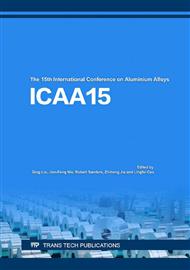[1]
M. Reich, O. Keßler, Quenching simulation of aluminum alloys including mechanical properties of the undercooled states, Matls Perf Charact. 1 (1) (2012) 104632.
DOI: 10.1520/mpc104632
Google Scholar
[2]
W.F. Hosford, S.P. Agrawal, Effect of stress during aging on the precipitation of θ' in Al-4 Wt pct Cu, Metall Trans A. 6 (3) (1975) 487–491.
DOI: 10.1007/bf02658406
Google Scholar
[3]
B. Skrotzki, G.J. Shiflet, E.A. Starke, On the effect of stress on nucleation and growth of precipitates in an Al-Cu-Mg-Ag alloy, MMTA. 27 (11) (1996) 3431–3444.
DOI: 10.1007/bf02595436
Google Scholar
[4]
A.W. Zhu, E.A. Starke, Stress aging of Al–xCu alloys: Experiments, Acta Materialia. 49 (12) (2001) 2285–2295.
DOI: 10.1016/s1359-6454(01)00119-7
Google Scholar
[5]
S. Fu, D. Yi, H. Liu, Y. Jiang, B. Wang, Z. Hu, Effects of external stress aging on morphology and precipitation behavior of θ" phase in Al-Cu alloy, T Nonferr Metal Soc. 24 (7) (2014) 2282–2288.
DOI: 10.1016/s1003-6326(14)63345-8
Google Scholar
[6]
D. Zohrabyan, B. Milkereit, O. Keßler, C. Schick, Precipitation enthalpy during cooling of aluminum alloys obtained from calorimetric reheating experiments, Thermochim Acta. 529 (2012) 51–58.
DOI: 10.1016/j.tca.2011.11.024
Google Scholar
[7]
M.J. Starink, B. Milkereit, Y. Zhang, P.A. Rometsch, Predicting the quench sensitivity of Al-Zn-Mg-Cu alloys: A model for linear cooling and strengthening, Materials and Design. 88 (2015) 958–971.
DOI: 10.1016/j.matdes.2015.09.058
Google Scholar
[8]
B. Milkereit, N. Wanderka, C. Schick, O. Keßler, Continuous cooling precipitation diagrams of Al-Mg-Si alloys, Mater Sci Eng A. 550 (2012) 87–96.
DOI: 10.1016/j.msea.2012.04.033
Google Scholar
[9]
B. Milkereit, O. Keßler, C. Schick, Recording of continuous cooling precipitation diagrams of aluminium alloys, Thermochim Acta. 492 (1-2) (2009) 73–78.
DOI: 10.1016/j.tca.2009.01.027
Google Scholar
[10]
M. Reich, O. Keßler, Mechanical properties of undercooled aluminium alloys and their implementation in quenching simulation, Mater Sci Technol. 28 (7) (2012) 769–772.
DOI: 10.1179/1743284711y.0000000085
Google Scholar
[11]
M. Reich, O. Kessler, Bauschinger effect in undercooled 6082 aluminium wrought alloy, HTM. 67 (5) (2012) 331–336.
DOI: 10.3139/105.110165
Google Scholar
[12]
J. Osten, B. Milkereit, C. Schick, O. Keßler, Dissolution and precipitation behaviour during continuous heating of Al-Mg-Si alloys in a wide range of heating rates: Materials, Mater. 8 (5) (2015) 2830–2848.
DOI: 10.3390/ma8052830
Google Scholar
[13]
I.J. Polmear, Light alloys: From traditional alloys to nanocrystals, 4th ed., Elsevier/ Butterworth-Heinemann, Oxford, (2005).
Google Scholar
[14]
S.C. Wang, M.J. Starink, Precipitates and intermetallic phases in precipitation hardening Al–Cu–Mg–(Li) based alloys, International Materials Reviews. 50 (4) (2005) 193–215.
DOI: 10.1179/174328005x14357
Google Scholar


